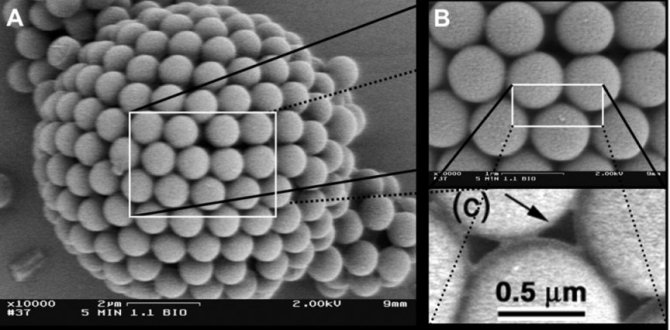Colloidosomes
Efficient encapsulation and controlled release of drugs, proteins, vitamins, flavors, fragrances, catalyst materials or even living cells are of increasing importance to the biomedical, pharmaceutical, cosmetic, and food industries. A variety of techniques have been developed to fabricate hollow particles for this purpose. However, despite the enormous progress in encapsulation technologies, these methods are often limited in their applicability, in the range of materials that can be used, in the uniformity of hollow sizes or in the easy of synthesis and yield.
Recently, there has been increased interest in using self-assembled colloids at emulsion droplet interfaces to form microcapsules called colloidosomes (Figure 1) because of the resemblance of their topology to that of liposomes and polymersomes. In the conventional method to produce colloidosomes emulsion droplets are used as 3D colloidal “templates” whose size and shape determine the morphology of the obtained particle aggregates. The capsule surface is composed of a close-packed layer of colloidal particles linked together to form a solid shell and the interstices between the particles form an array of uniform pores. Unfortunately, current approaches rely on bulk emulsification methods that produce colloidosomes with a size distribution, and further these methods are restrictive with respect to the materials employed because of the special characteristics needed in the water-solid-oil system. On the other hand, methods that exploit the great potential of interfacial assembly for producing microcapsules have been hampered by the lack of understanding of the assembly process.

Figure 1: SEM image of a colloidosome; polystyrene spheres sintered by heating (Picture courtesy of Dinsmore Science 298, 1006-1009 (2002))
The main goal of this project is: Development of new nano- and micron-sized colloidosomes and polymersomes based on water-oil, oil-water, and water-water systems, together with microchannel processing technology for colloidosomes. The production of colloidosomes will be approached experimentally and computationally
Literature
- Colloidosomes: Selectively permeable capsules composed of colloidal particles
A. D. Dinsmore, M. F. Hsu, M. G. Nikolaides, M. Marquez, A. R. Bausch, D. A. Weitz, Science, 298, 1006-1009 (2002)
Acknowledgement
The project is a collaboration project between the Food Physics group and the Food Process Engineering group of Wageningen University, and part of the national research initiative MicroNed. Francisco Rossier is personally sponsored by the Programme AlBan, the European Union Programme of High Level Scholarships for Latin America, scholarship No.E05D060840CL.

